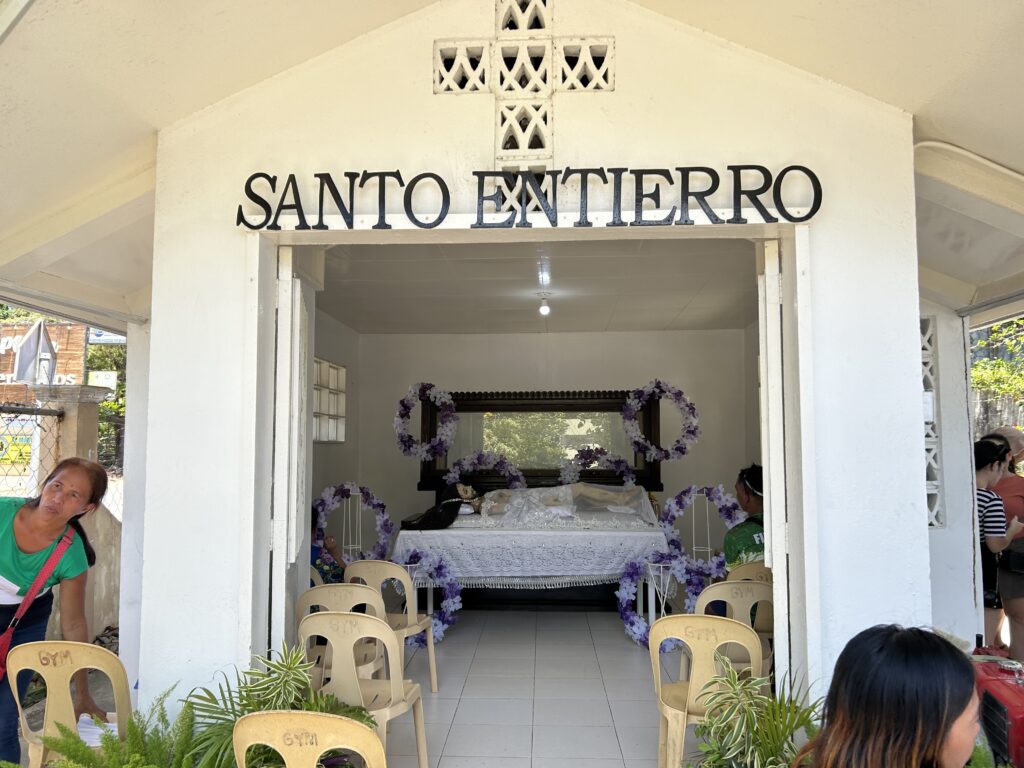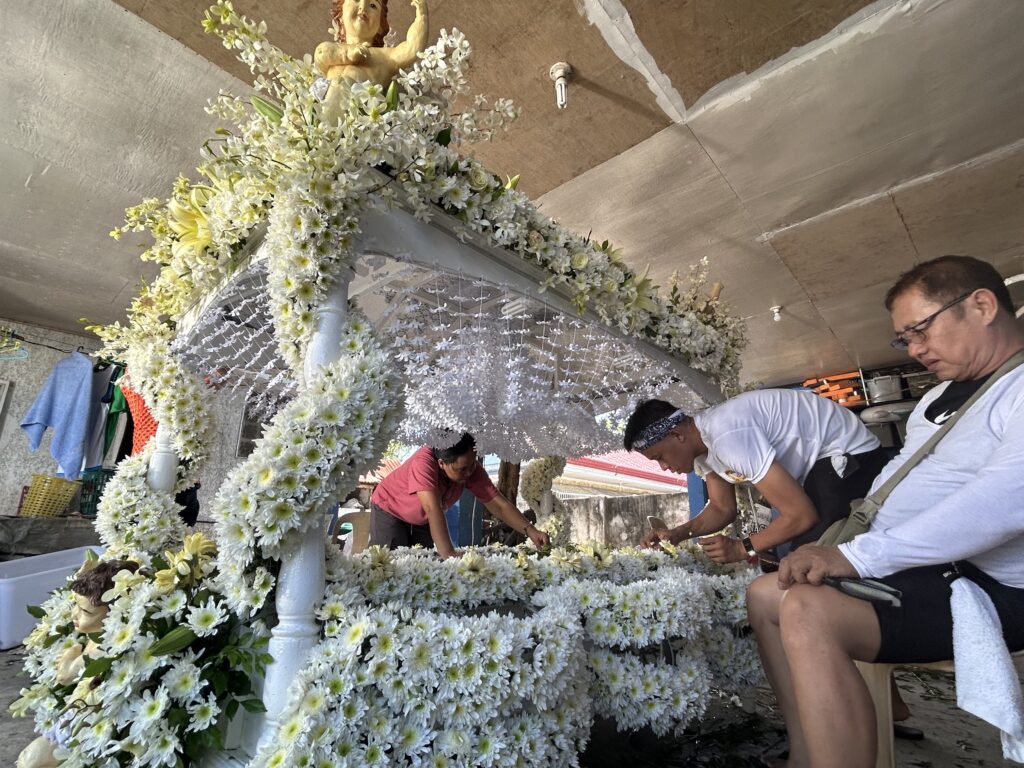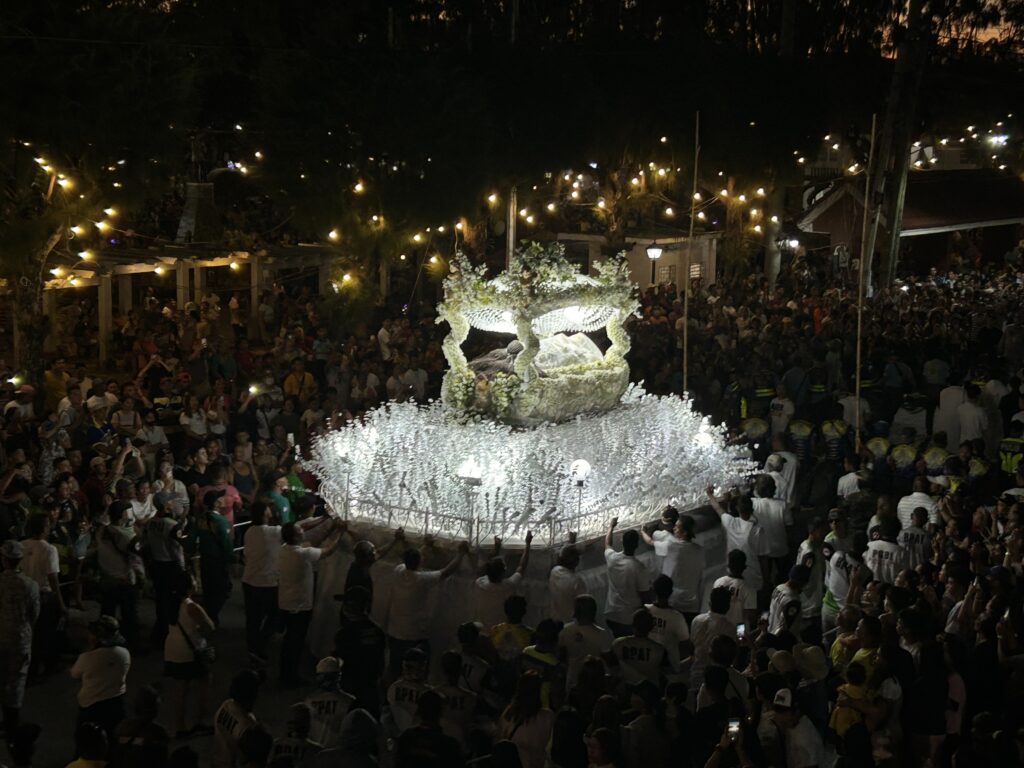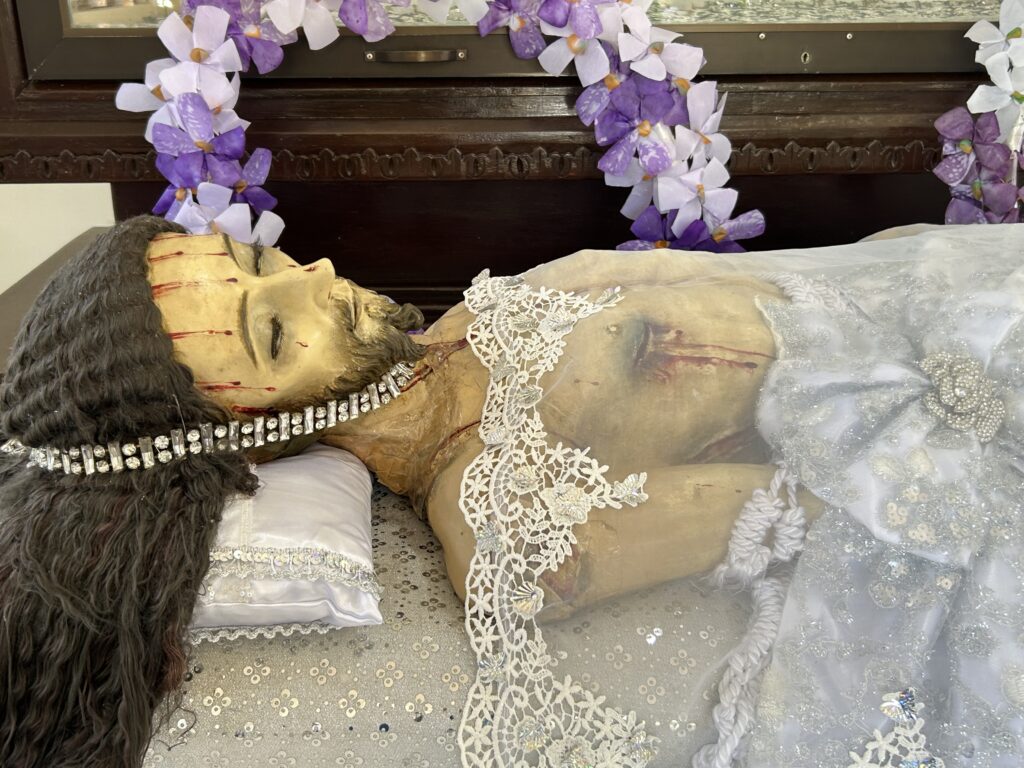
A close-up look at the famous Santo Entierro image in Bantayan. | CDN Digital Photo by Morexette Marie Erram
CEBU CITY, Philippines – The sun was beating down harshly one Friday at noon in Bantayan town in northern Cebu.
In a family-owned compound in Barangay Ticad, its residents, workers, and volunteers did not mind the hot and humid weather as they put fresh, white flowers around a huge, wooden platform.
A few minutes later, they moved the flower-bedecked platform on top of a generator-powered carroza or carriage.
That carriage, in turn, will be carrying an image that has shaped Bantayan as a place where Catholics observe the Holy Week, and the lives of several families from this first-class municipality.
READ: What to expect in Bantayan’s Santo Entierro procession
Eight generations of the families Jimenez, Maderazo, and Desphy have served as caretakers, or camareros, of the Santo Entierro statue in Bantayan. The Santo Entierro procession every Good Friday draws hundreds – if not, thousands – of devotees to witness and join the penitential walk around the town center for the Holy Week.
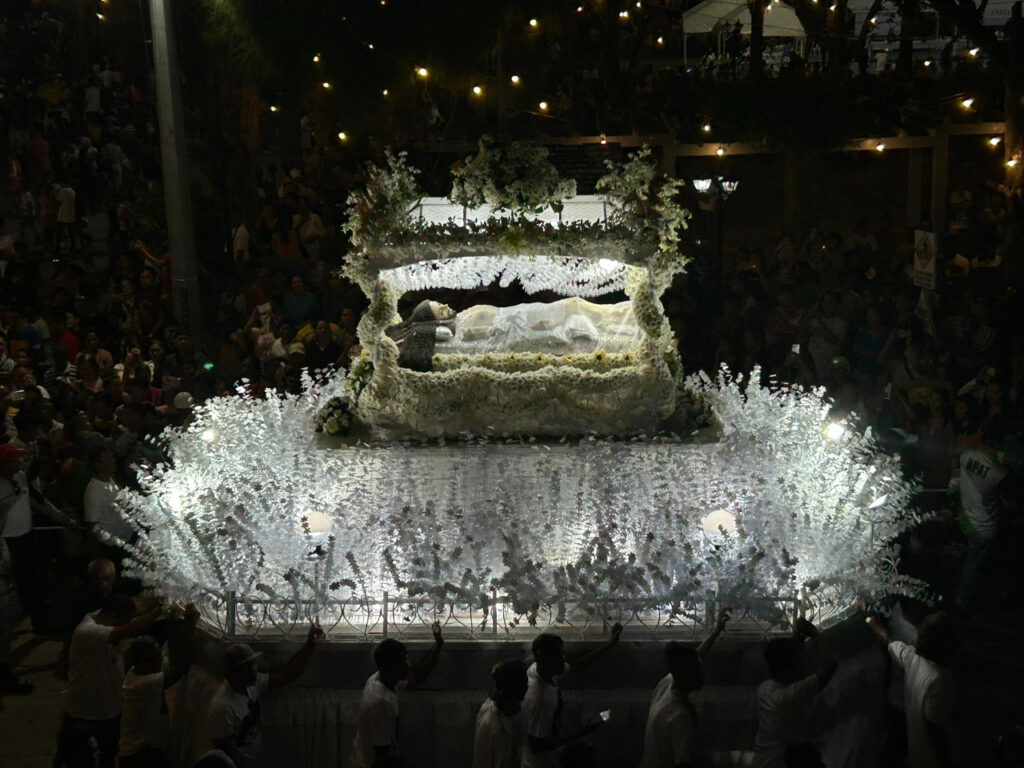
Eufemia ‘Eufie’ Chiong is a fifth-generation camarera.
Even at 78, Eufie flies every year, together with her children and grandchildren, from Davao City to Bantayan to join the procession of the dead Christ.
“Bisag nibalhin nami og Davao og didto nako nidako ug nagminyo, kada tuig inig Semana Santa, mubalik mi dinhe sa Bantayan,” Eufie said.
Santo Entierro means Holy Internment in Spanish. It is also the term used to name both the carroza and the image of the dead Jesus Christ during solemn processions every Good Friday.
The one in Bantayan is believed to have been brought by the Spaniards to the island between the 18th and 19th centuries. It also happens to be one of the oldest and most famous religious relics in town.
Previously housed in Bantayan’s parish church, the Parroquia de San Pedro Apostol, the modern generations of camareros from the three families decided to take it upon themselves to guard and care for the image.
They sold some personal valuables, like real estate properties, and set aside portions of their savings to fund the construction of a chapel for the Santo Entierro in Barangay Ticad, where visitors and the faithfuls can venerate it even outside Holy Week.
“Gipahimuan gyud na siya og kapelya sa among mga ig-agaw,” said Brenda Enchavez, Eufie’s younger sister and like her, a fifth-generation camarera.
READ: What is Santo Entierro?
The chapel has its own electrical connection, with floors made of tiles and walls painted in fresh white. They also had a glass coffin made to preserve the Santo Entierro and prevent it from gathering dust.
This year, Eufie and Brenda decided to put on a new pillow and new clothes for the Santo Entierro. These were even handmade by a seamstress all the way from Davao, who knew the dimensions of the statue.
The procession
Like many big events, the Santo Entierro procession in Bantayan takes months to prepare. And leading the preparations are no other than the camareros themselves.
Miko Petallana is a member of the seventh-generation camarero.
A Millennial, Miko has been overseeing nearly all aspects of the Santo Entierro procession for the Holy Week in 2024- from purchasing flowers to ensuring all volunteers are accommodated.
Preparation for the Santo Entierro procession usually takes between six to seven months before the Holy Week, he said.
“Di gyud na siya angay i-dali-dalian… As early as September, gisugdan na namo ang preparations,” said Miko.
The camareros had to make sure the flowers they would adorn on the Santo Entierro’s platform remained fresh throughout the procession.
On top of that, they had to look for volunteers, particularly for the roles of wreath bearers, and hire laborers to work on the carroza.
They also decided to ask help from the local government in guarding the carroza as the crowd, in the past processions, would sometimes scramble and fight over to grab its flowers.
“Sa una, mga taga ROTC man to mag guardiya sa carroza. Karun, ang LGU (local government unit) mitabang and mideploy og mga police sa carroza arun di na (mahitabo ang sauna nga mag-ilogay sa buwak),” Miko explained.
Since the descendants of the first camarerors of Bantayan’s Santo Entierro are scattered around the world, keeping everyone aligned for its procession on Good Friday can be challenging.
This is why constant communication is important, said Miko.
READ: Cotabato cops hold priest over cargo of dead Christ
“Communication is key gyud. As long as proper communication is being done, ma-streamline gyud ang among preparations bisag ang uban naa sa gawas,” he added.
All these involved time, energy, and money – which the camareros and the volunteers saw as worthy sacrifices to show their faith in Jesus Christ.
Miraculous
Aside from its heritage value, the Santo Entierro in Bantayan is known for reportedly being miraculous – hence the ‘uncontrollable crowd’ grabbing the flowers off of its carroza in pre-pandemic Good Friday processions.
As the original camareros and camareras expanded their family trees, some migrated to other places like Eufie and Brenda who decided to settle down in Davao City.
But the miracles and blessings in taking care of the dead Christ led Eufie and Brenda to make it a tradition to return to Bantayan every Holy Week, and continue caring for the Santo Entierro.
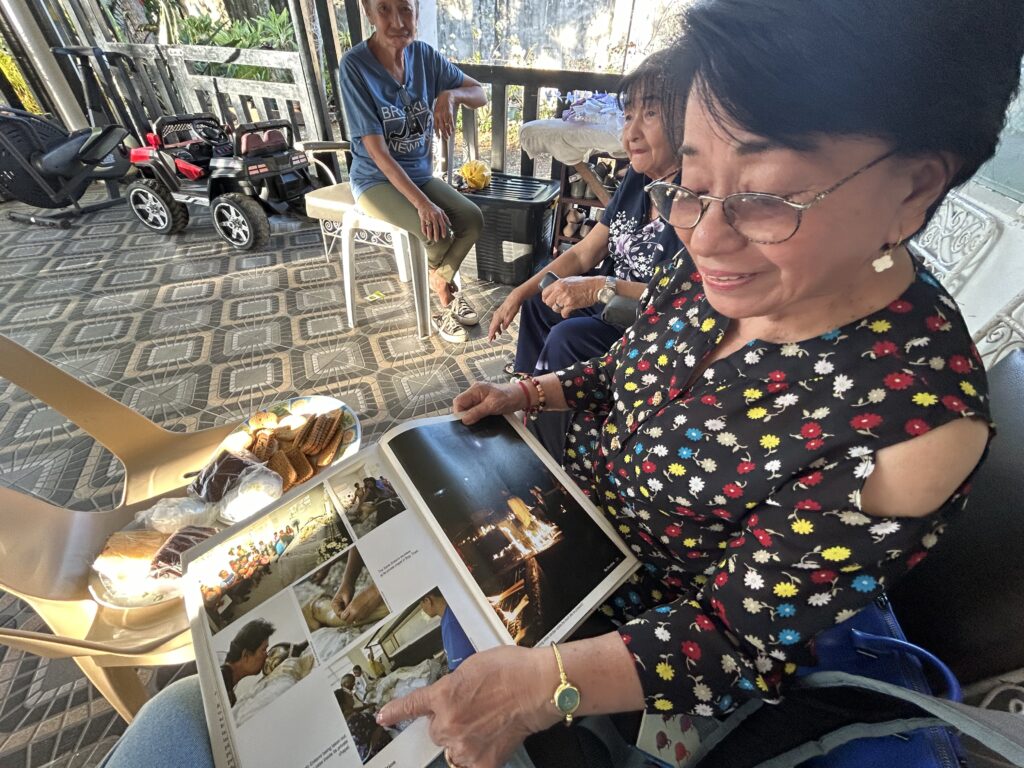
Eufemia Chiong points to a picture of her taken in 2015 and published in a book about the religious tradition in Bantayan Island | CDN Digital Photo by Morexette Marie Erram
Eufie, for her part, can still clearly recall how her father salvaged the Santo Entierro from a burning house in the late 1960s.
At that time, a huge fire erupted in Bantayan’s town center. It started from a bakery then spread to nearby establishments and houses, including one that housed the Santo Entierro.
It remained fresh in Eufie’s memories the image of her father carrying the statue of the dead Christ from the second floor of the burning house and then outside to safety rather effortlessly.
“Matud sa akong papa, gaan ra daw kaayo… Wa sad daw gani siya naglisud pagpanaog niya nga ang hagdan sa balay sa akong tiyo kay taas ug habog. Unya, wala gyud siya maunsa,” said Eufie.
READ: The empty tomb: What science says about the resurrection of Christ
The 78-year-old camarera also shared how descendants of laborers and volunteers keep coming back every Holy Week to help in the preparation for the procession.
Some of them attributed the blessings their families received, like having all of their children complete their education, to the sacrifices they made for the Santo Entierro.
“Kay nahimo na sad nga tradisyon sa ilahang pamilya ug naay uban miingon nga dako gyud kuno og tabang ug grasya gihatag ang Santo Entierro nila,” said Eufie.
Reunion
During Holy Week in the Santo Entierro chapel in Barangay Ticad, it’s almost like a family reunion for the descendants of the first generation of camareros.
Even if the family trees of the first camareros had grown longer and more complex, the devotion they have for the Santo Entierro remained unwavering.
This is why Eufie made it a tradition to go back to Bantayan every Holy Week and bring her grandchildren so they too can witness and experience the miracles of the Santo Entierro.
And for younger camareros like Miko, faith is transcendental and does not end at decorations only.
In the upcoming and future Santo Entierro processions, the new generations of camareros and camareras urged faithfuls to always uphold their sincerity and love for Jesus Christ.
“Dapat ang ilahang focus kay ang sakripisyo. Nga muambit sila sa kasakit ni Kristo. Kana na lang daan sa prosesyon, niduyog ka, niambit naka sa kasakit ni Hesu Kristo,” said Miko.
